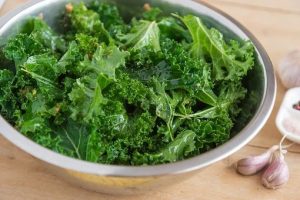Written by Jessica Patella, ND. A balanced diet, including raw and cooked Brassica vegetables, may provide the most health-promoting benefits against aflatoxin exposure.
 Brassica vegetables are often suggested and studied for their effects on health. Vegetables in the Brassica family include, broccoli, kale, cauliflower, Brussels sprouts, cabbage, collard greens and bok choy 1,2. Research has even suggest cancer preventative effects of these vegetables due to the fact they have been shown to improve detoxification and decrease inflammation and oxidative stress in the body 3,4. Recent research investigated if consuming these vegetables raw or cooked made a difference 1.
Brassica vegetables are often suggested and studied for their effects on health. Vegetables in the Brassica family include, broccoli, kale, cauliflower, Brussels sprouts, cabbage, collard greens and bok choy 1,2. Research has even suggest cancer preventative effects of these vegetables due to the fact they have been shown to improve detoxification and decrease inflammation and oxidative stress in the body 3,4. Recent research investigated if consuming these vegetables raw or cooked made a difference 1.
For the research, the specific Brassica vegetable investigated was Brassica carinata, or Ethiopian kale. The leaves and seeds of the plant are rich in glucosinolates and polyphenols 1,5. In addition, a recent in vitro study found the extract of Brassica carinata protective against aflatoxin B1 in liver cancer cells 6. Aflatoxin B1 is the most potent naturally occurring liver carcinogen and is commonly found in peanuts, grains and animal feed 1,7. Due to the fact that Ethiopian kale is a bitter green it is often preferred cooked as cooking reduces the bitter flavor, but extensive cooking might affect the phytochemicals and therefore reduce the health benefits 1. Therefore, the researchers assessed the effects of both raw and cooked kale to determine if there if a best way to consume it 1.
The research included 24 healthy participants (5 male, 19 female) that were randomly assigned to either a cooked kale group (n=12) or raw kale group (n=12). The participants received the food for 5-days, and then there was a 16-day break, followed by a crossover where they received the opposite preparation of kale for another 5-days 1.
The kale leaf was prepared fresh daily from a powder that was prepared for the study (15g freeze dried, ground B. carinata leaves in 200 mL drinking water). The raw kale was prepared from raw leaves that were freeze-dried directly after harvesting. The cooked kale was prepared from freeze-dried leaves that were then cooked for 10-minutes in boiling water, cooled and then freeze-dried again 1. Researchers analyzed the nutrient content of these preparations and found the following:
- Raw leaves contained: 177 µmoL AITC (allyl isothiocynates, which are attributed to the cancer preventative effects from the plant) per serving and 6 µmoL sinigrin (the precursor to AITC) per serving
- Cooked leaves contained: 0 µmoL AITC per serving and 296 µmoL sinigrin per serving
- Total polyphenol content was not significantly changed with cooking
Blood and urine samples were collected after fasting before and after each intervention period in each participant. The following results were observed:
- No AITC metabolites were detected in the blood or urine before each intervention, which indicates the wash-out period was effective.
- AITC metabolites were not detected in blood or urine of any participants that consumed the cooked kale leaves.
- When blood cells were exposed to aflatoxin B1 those that consumed cooked kale leaves had significantly reduced DNA damage compared to baseline levels (p<0.01), where the raw kale leaves only reduced DNA damage by 21%, but it did not reach significance (p=0.08)
- Only the raw preparation of kale leaves significantly reduced inflammatory markers in the blood (prostaglandin E2, p<0.01)
- No changes in blood antioxidant capacity were observed.
In conclusion, there appears to be benefit to consuming both raw and cooked Ethiopian kale as part of the diet 1. The cooked kale protected against DNA damage from aflatoxin, while the raw kale increased AITC metabolites and decreased inflammatory markers in the body 1. This is a pilot study and this should be investigated in a larger, long-term study to confirm results 1.
Source: Schlotz, Nina, Grace A. Odongo, Corinna Herz, Hanna Waßmer, Carla Kühn, Franziska S. Hanschen, Susanne Neugart et al. “Are Raw Brassica Vegetables Healthier Than Cooked Ones? A Randomized, Controlled Crossover Intervention Trial on the Health-Promoting Potential of Ethiopian Kale.” Nutrients 10, no. 11 (2018): 1622.
© 2018 by the authors. Licensee MDPI, Basel, Switzerland. This article is an open access article distributed under the terms and conditions of the Creative Commons Attribution (CC BY) license (http://creativecommons.org/licenses/by/4.0/).
Click here to read the full text study.
Posted April 21, 2020.
References:
- Schlotz N, Odongo GA, Herz C, et al. Are Raw Brassica Vegetables Healthier Than Cooked Ones? A Randomized, Controlled Crossover Intervention Trial on the Health-Promoting Potential of Ethiopian Kale. Nutrients. 2018;10(11):1622.
- Higdon JV, Delage B, Williams DE, Dashwood RH. Cruciferous vegetables and human cancer risk: epidemiologic evidence and mechanistic basis. Pharmacol Res. 2007;55(3):224-236.
- van Poppel G, Verhoeven DT, Verhagen H, Goldbohm RA. Brassica vegetables and cancer prevention. Epidemiology and mechanisms. Adv Exp Med Biol. 1999;472:159-168.
- Sturm C, Wagner AE. Brassica-Derived Plant Bioactives as Modulators of Chemopreventive and Inflammatory Signaling Pathways. Int J Mol Sci. 2017;18(9).
- Neugart S, Baldermann S, Ngwene B, Wesonga J, Schreiner M. Indigenous leafy vegetables of Eastern Africa – A source of extraordinary secondary plant metabolites. Food research international (Ottawa, Ont). 2017;100(Pt 3):411-422.
- Odongo GA, Schlotz N, Herz C, et al. The role of plant processing for the cancer preventive potential of Ethiopian kale (Brassica carinata). Food Nutr Res. 2017;61(1):1271527.
- Goodman G, Wilson R. Predicting the carcinogenicity of chemicals in humans from rodent bioassay data. Environ Health Perspect. 1991;94:195-218.

